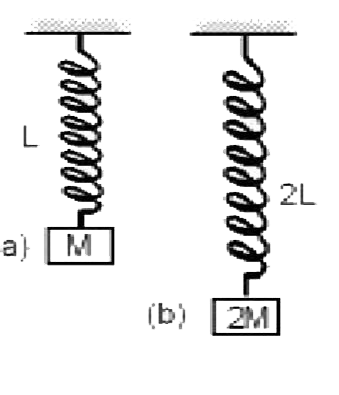Two springs of the same material but of length L and 2L are suspended with masses M and 2M attached at their lower ends. Their time periods when they are allowed to oscillate will be in the ratio

1:2
2:1
1:4
4:1
The correct Answer is:A
Step by step video & image solution for Two springs of the same material but of length L and 2L are suspended with masses M and 2M attached at their lower ends. Their time periods when they are allowed to oscillate will be in the ratio by Physics experts to help you in doubts & scoring excellent marks in Class 12 exams.
Updated on:21/07/2023Topper's Solved these Questions
- SIMPLE HARONIC MOTION BOOK - MOTIONCHAPTER - SIMPLE HARONIC MOTION EXERCISE - EXERCISE -1 ( SECTION-E,F ) ( – Angu lar shm & s implependulum)
10 Videos
- SIMPLE HARONIC MOTION BOOK - MOTIONCHAPTER - SIMPLE HARONIC MOTION EXERCISE - EXERCISE -1 ( SECTION - G ) ( Compound pendulum / physical pendulum, torsional pendulum
5 Videos
- SIMPLE HARONIC MOTION BOOK - MOTIONCHAPTER - SIMPLE HARONIC MOTION EXERCISE - EXERCISE -1 ( SECTION-C ) ( Two block system)
6 Videos
- SIMPLE HARMONIC MOTIONBOOK - MOTIONCHAPTER - SIMPLE HARMONIC MOTIONEXERCISE - EXERCISE -3 Section - B Previous Year Problems | JEE MAIN
23 Videos
- SOUND WAVESBOOK - MOTIONCHAPTER - SOUND WAVESEXERCISE - Exercise - 3 (Section - B)
14 Videos
Similar Questions
The ratio of Young's modulus of two springs of same area of cross section and same length is 5 : 4 Equal masses are suspended from these springs. On stretching and then releasing, the springs start oscillating. Calculate the ratio of time period of oscillation.
View SolutionSprings of apring constants k,2k,4k,8k . . . Are connected in series. A mass m kg is attached to the lower end of the last spring and the system is allowed to vibrate. What is the time period of oscillations?
View Solution
Knowledge Check
A spring elongated by length 'L' when a mass 'M' is suspended to it. Now a tiny mass 'm' is attached and then released, its time period of oscillation is -
A2π√(M+m)lMgB2π√mlMgC2π√L/gD2π√Ml(m+M)gA metal wire of length L is suspended vertically from a rigid support. When a bob of mass M is attached to the lower end of wire, the elongation of the wire is l:
AThe loss in gravitational potential energy of mass M is Mgl.BThe elastic potential energy stored in the wire is MglCThe elastic potential energy stored in the wire is 12MglDHeat produced is loss of mechanical energy of system is 12MglThe young modulii of two springs of equal length and equal cross sectional areas are in the ratio 2:3 both the springs are suspended and loaded with the same mass . When springs are stretched and released , the time period of oscillation of the two springs is in the ratio of
A3:2B2:3C√3:√2D√2:√3
Springs of spring constants k, 2k, 4k, 8k, …… are connected in series. A mass m kg is attached to the lower end of the last spring and the systemm is allowed to vibrate. What is the time period of oscillations? Given m=40gm,k=2.0Ncm−1.
View SolutionTwo springs of equal lengths and equal cross-sectional area are made of materials whose Young's moduli are in the ration of 2:3 . They are suspended and loaded with the same mass. When stretched and released they oscillate. Find the ratio of the time period of oscillation.
View SolutionA body of mass M is attached to the lower end of a metal wire, whose upper end is fixed . The elongation of the wire is l.
View SolutionTwo springs of equal lengths and equal cross sectional area are made of materials whose young's moduli are in the ratio of 3 : 2. They are suspended and loaded with the same mass. When stretched and released, they will oscillate with time period in the ratio of
View SolutionA body of mass m is suspended from vertical spring and is set into simple harmonic oscillations of time period T. Next the spring is fixed at one end on a smooth horizontal table and same body is attached at the other end. The body is pulled slightly and then released to produce horizontal oscillations of the spring. The time period of horizontal oscillations is
View Solution
